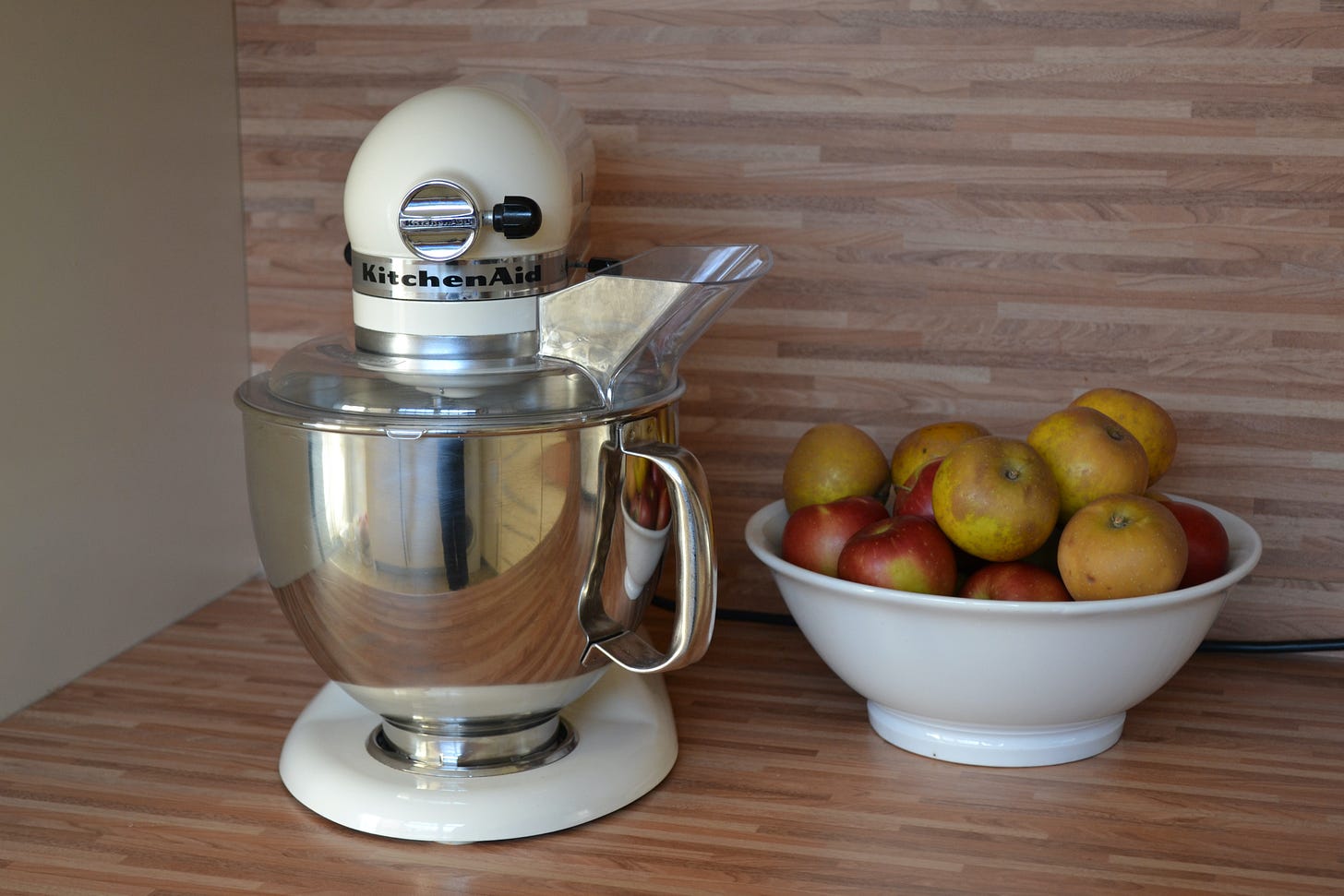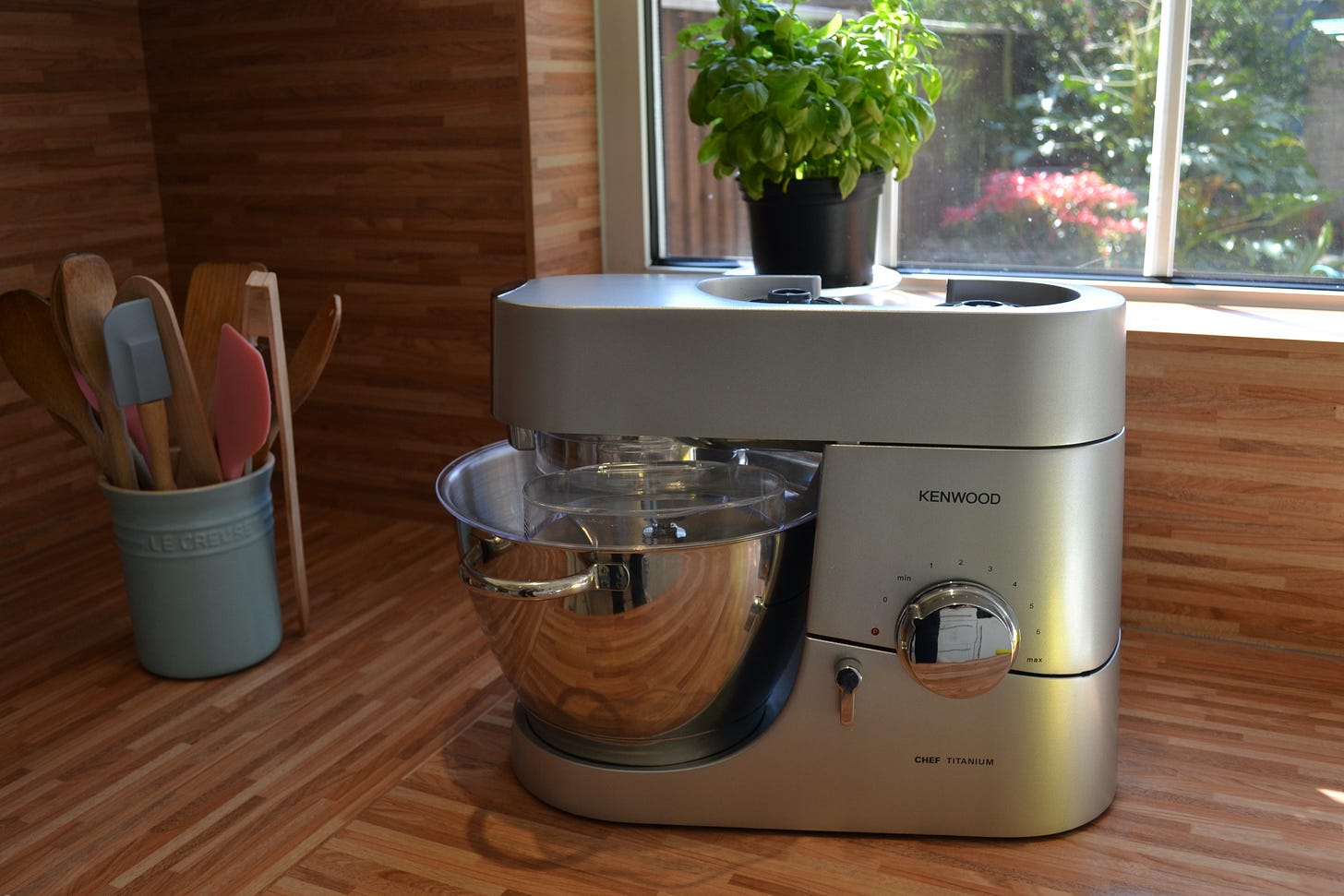A guide to buying stand mixers and whisks
A useful piece of equipment for any baker. Here's what you need to know...
As a keen baker, one of the questions I am asked most is which mixer I recommend. An electric mixer or whisk of some sort is an extremely useful tool for anyone who bakes regularly. Many models though require a considerable investment, so here are all the pros and cons you need to know to make the right choice for you.
I’ll start with the Kitchen Aid stand mixer, as this is the machine I am most asked about. They are very covetable and look attractive in the kitchen, with the wide range of colours and pleasing retro design.
I have had three of the 4.8l stand mixers. I have given one away and still have two. The oldest is around 15 years old and is still working well, despite the thousands of hours of work it’s done. The 4.8l is the standard size for domestic use, but more recently, as smaller size has been brought out as part of a lower cost line. Expect to spend around £450 for the basic version in this size.
Most packages will come with a metal bowl, splash guard, whisk attachment, paddle beater and dough hook. Glass bowls are nice and are around £80/90 each. I have one and like it - simply as I often find a second bowl is useful to use at the same time.
I always use it to make meringues - it is so much easier to leave the mixer running (under careful supervision), than to stand over a bowl with a whisk, as it can take around 10 minutes to get the meringue mixture to the desired stage. Ditto with bread dough. I make all my bread from scratch, and the dough hook kneading function is so useful to me. I do often use the machine to make cakes, but bread making tends to be the main activity for me.
I have given a Kenwood machine to someone who loves to bake but has some dexterity challenges, and it’s been a revelation for them, helping them to bake with much more ease and enjoyment.
This size machine is useful for keen home cooks, but has its limitations. When making loaves, I struggle to make two loaves worth of dough in one go (assuming an average loaf is made with 500g flour), and the mixture gets wound around the top of the attachment. If you want to make larger quantities of mixture in one go, I suggest looking at the professional model with its 6.9l bowl, or a Kenwood Chef XL.
Here are my Kitchen Aid pros and cons to consider:
Pros
A reliable motor, with reasonable power to knead and whisk effectively
A durable construction that withstands plenty of wear
Stylish and colour-co-ordinated looks to leave on the side in the kitchen
Effective tools for whisking, kneading and beating
Cons
Other machines (Kenwood) do have more powerful motors
The splashguard isn’t that effective. I find small pulses to get a mixture started prevents too much of a flour or icing sugar cloud
The whisk will not go in the dishwasher
Lots of nooks and crannies to clean
The attachments are not really worth it - separate tools are often cheaper and more effective, such as a mincer or pasta rolling machine
The main competitor to the Kitchen Aid is the Kenwood mixer. The Kenwood has been around for decades and have a reputation for longevity. They really are passed down through the generations and keep on going.
There are two specific versions I will cover here. There is the Kenwood Chef, which is the smaller domestic version with a 4.6l bowl and the XL with a 6.4l bowl. I have owned and used both. Expect to spend anything between £300 and £900, depending on the size and model you choose. They will all come with a whisk, dough hook and paddle, often known as a "‘k’ beater.
Expect a real workhorse here, with a motor that really should last well. Looks-wise, it’s not as stylish as the Kitchen Aid, but this machine excels at function, rather than form.
Here are my Kenwood pros and cons to consider:
Pros
Really should last a lifetime
Easier to clean, with fewer surfaces and nooks and crannies to clean
The 360 splashguard is better at keeping powdery ingredients contained
The pulse function is very useful. Kitchen Aid does not have this feature.
Very well-designed attachments, especially the whisk
I love the blender attachment, which works extremely well
Cons
The metal rim on the bowl is quite sharp and it’s easy to hurt yourself when removing the bowl. I prefer the models with handles on the bowl
The flap on the splashguard has a flimsy hinge which can break easily
There are other brands, such as Bosch, who make stand mixers, but I have yet to find one I like and would recommend. Many are cheaper, but in all honesty, I’d recommend finding a second hand good quality model rather than compromising on an inferior machine if budget is an issue.
I also want to touch on the hand held electric whisk. This is a terrific piece of equipment for cake making, cream whipping and meringue making for a much lower cost.
If you want a small piece of equipment with a much lower price tag, I really recommend an electric whisk with beaters. They take up so little space, are easy to clean and do not require a large outlay to acquire. I won’t knead bread though, even though they do have an attachment for the job - they don’t work very well.
The best advice I can give you here is to look at the motor size. I have a high powered Kenwood model (sadly now discontinued), which is excellent and so much more effective than the entry level model. Dualit also produce a more powerful model. The difference is genuinely striking and I can’t recommend ‘upgrading’ your motor size enough. Look for a 400W Dualit or Kenwood ideally.
The Kitchen Aid model has a rather underpowered motor (85W!) and is over double the price. The digital display is very slow to react and a pain to use, so I really do not recommend this model. I also recommend steering clear of the really cheap models - they are pretty dismal to use and can break very quickly. I’ve taught in cookery schools that have used them and there were many complaints from customers and broken appliances after no time at all.
I sincerely hope this guide has been useful. Please drop me a question below if there is anything I’ve forgotten to cover, or you’d like to ask. And let me know how you are getting on with yours, if you have one already, or decide to invest.





